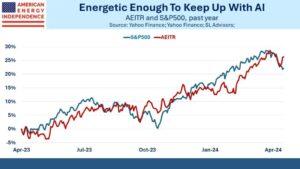Portfolio Manager Denny Fish and the Global Tech and Innovation Team explain how advanced artificial intelligence (AI) such as that powering the popular ChatGPT platform has the potential to exponentially increase the capability of computing and how society interacts with technology.
Key takeaways:
- The technology underpinning the popular ChatGPT platform represents a step function in advanced computing’s potential to deliver productivity gains across the global economy.
- We view AI not only as one of the technology mega-themes pulling the global economy toward a digital future, but also as a connective thread that maximizes other themes such as cloud computing.
- Leaps forward in technology tend to be accompanied by attractive investment opportunities, and advanced AI will likely offer investors a range of avenues to gain exposure to this powerful trend.
Every so often an innovation emerges that captures the attention of not only the technology and scientific community, but – due to its groundbreaking nature – broader society as well. Think Sputnik, the introduction of smartphones, or the mapping of the human genome.
Last November’s launch of OpenAI’s ChatGPT chatbot has the potential to achieve this lofty status. And like other innovations that seemingly appeared out of nowhere, ChatGPT and the technology that underpins it have been years in the making.
A mega-theme – and a common thread
We believe the buzz generated by ChatGPT is owed to it exemplifying the degree to which artificial intelligence (AI) has progressed and how it has the potential to not only redefine what’s possible with advanced computing, but also dramatically change how businesses and society interface with technology.
We consider AI one of the mega-themes that – along with the Internet of Things (IoT), Software as a Service (SaaS), the cloud, and 5G connectivity – is pulling the global economy toward a digital future. Yet, in addition to being a theme in its own right, AI is a connective thread lacing through other themes by optimizing data and computing power to deliver productivity-enhancing solutions that these other technologies could not achieve on their own.
While a chatbot capable of penning poems may seem like a mere novelty, the underlying technologies of Large Language Models (LLM) and generative AI are not; they are game changers. Generative AI, simply defined, is technology that enables computers to create human-like content largely based on its own inferences from data sources rather than taking cues from human inputs. LLMs, meanwhile, are capable of predictive text like those already integrated with voice-activated assistants.
While a chatbot capable of penning poems may seem like a mere novelty, the underlying technologies of Large Language Models (LLM) and generative AI are not; they are game changers.
Within the past few years, AI’s scope and complexity have grown exponentially. Behind this growth are advancements in the capabilities of the graphic processing units (GPUs) that power the cloud. These are achieved by parsing tremendous quantities of data and seeking linkages and interpretations likely beyond the capacity of humans.
Paradigm shift
This increase in computing power, along with the larger data sets it can analyze, represents what we consider a step function in productivity gains. It is only the latest in a string of technological advancements that have propelled the global economy for over half a century. First, mainframe computers enabled corporations and governments – entities that could afford them – to analyze and solve a range of tasks that had previously seemed insurmountable. This era was followed by the rollout of servers and personal computers and then the Internet and mobile technology. Each of these periods demonstrated the industry axiom that if people and businesses have access to novel technologies, they will take advantage of them, often in unexpected ways – including the creation of entirely new applications and business models.
The step function represented by AI extends the capabilities of other tech mega-themes, especially the cloud and the data housed within it. Importantly, with each paradigm shift we can expect exponential growth in the addressable market as established businesses and entrepreneurs alike seek creative ways to deploy these advancements. The result should be broad-based productivity gains that have the potential to benefit the entire global economy. And while disruptive technology inevitably leads to the cannibalization of some existing platforms, those losses are far outweighed by the wider adoption and greater efficiencies of the disruptors.
Only getting started
Despite the sophistication of ChatGPT, the technology is still relatively immature. Generative AI is bound to have some false starts, and while this technology is mostly in the experimental stage, it has already been deployed in commercial applications. That will only grow. Customer interaction functions, in our view, are a particularly ripe opportunity for chatbots and related applications as they have the potential to improve the customer experience by rapidly analyzing myriad data points to diagnose problems with the aim of achieving a favorable outcome.
Middle-office tasks and even software coding also stand to benefit, as AI can assume responsibility for the more mundane steps, thus freeing up workers to concentrate on value-added functions. Already Microsoft offers a service, Copilot, capable of generating lines of code. These examples reinforce our view that AI is an infrastructure layer upon which solutions aimed at specific business verticals will be created. To envisage the potential breadth of these verticals, one only has to look to the evolution of SaaS and how developers scoured every economic sector and business function to identify areas where they could apply bespoke solutions.
With innovation comes opportunity
As with many innovations, the potential for investment in advanced AI is also evolving. OpenAI – ChatGPT’s creator – is not open to public investment. But advanced AI’s and related technologies’ potential for generating attractive returns, in our view, is immense. Historically, step changes in productivity can lead to a decade or more of efficiencies being wrung out of the economy. Where companies can save, investors can profit.
Two industries leveraged to the rollout of AI are the semiconductor complex – both GPU producers and semi capital equipment manufacturers – and the public cloud providers that collect and store the data that are the feedstock of advanced computing. Many companies seeking investment capital will focus on creating solutions for specific business verticals. While some will be new ventures, existing software companies are likely to continue to integrate AI into their offerings to add even more value for their clients.
Lastly, forward-looking non-tech companies are likely to seek ways to integrate AI across operations with the goal of improving efficiencies and increasing profitability. Already agriculture companies have begun deploying AI to optimize crop yields by monitoring weather and soil conditions in real time and making planting and harvesting decisions accordingly.
Expanding the digital economy’s reach
ChatGPT is a discrete application of generative AI and LLM, but the computing power required by this single service is immense. For other advanced AI applications to permeate the global economy, two conditions must move in a favorable direction: Computing capacity must increase exponentially, and the unit cost of these complex calculations must fall.
These restraints, in our view, will influence the speed at which advanced AI is deployed. Yet, inevitably, they will be integrated across the global economy, even in sectors and regions that have been slow to adopt existing technologies. In this respect, generative AI and other advanced AI applications have the potential to become the first steps in the “last mile” of bringing the full capabilities of a digital future to all corners of the world.
IMPORTANT INFORMATION
Technology industries can be significantly affected by obsolescence of existing technology, short product cycles, falling prices and profits, competition from new market entrants, and general economic conditions. A concentrated investment in a single industry could be more volatile than the performance of less concentrated investments and the market as a whole.
—
Originally Posted February 2, 2023 – ChatGPT: Only the beginning of advanced AI’s transformative potential
Disclosure: Janus Henderson
The opinions and views expressed are as of the date published and are subject to change without notice. They are for information purposes only and should not be used or construed as an offer to sell, a solicitation of an offer to buy, or a recommendation to buy, sell or hold any security, investment strategy or market sector. No forecasts can be guaranteed. Opinions and examples are meant as an illustration of broader themes and are not an indication of trading intent. It is not intended to indicate or imply that any illustration/example mentioned is now or was ever held in any portfolio. Janus Henderson Group plc through its subsidiaries may manage investment products with a financial interest in securities mentioned herein and any comments should not be construed as a reflection on the past or future profitability. There is no guarantee that the information supplied is accurate, complete, or timely, nor are there any warranties with regards to the results obtained from its use. Past performance is no guarantee of future results. Investing involves risk, including the possible loss of principal and fluctuation of value.
Disclosure: Interactive Brokers
Information posted on IBKR Campus that is provided by third-parties does NOT constitute a recommendation that you should contract for the services of that third party. Third-party participants who contribute to IBKR Campus are independent of Interactive Brokers and Interactive Brokers does not make any representations or warranties concerning the services offered, their past or future performance, or the accuracy of the information provided by the third party. Past performance is no guarantee of future results.
This material is from Janus Henderson and is being posted with its permission. The views expressed in this material are solely those of the author and/or Janus Henderson and Interactive Brokers is not endorsing or recommending any investment or trading discussed in the material. This material is not and should not be construed as an offer to buy or sell any security. It should not be construed as research or investment advice or a recommendation to buy, sell or hold any security or commodity. This material does not and is not intended to take into account the particular financial conditions, investment objectives or requirements of individual customers. Before acting on this material, you should consider whether it is suitable for your particular circumstances and, as necessary, seek professional advice.










![[Gamma] Scalping Please [Gamma] Scalping Please](https://ibkrcampus.com/wp-content/smush-webp/2024/04/tir-featured-8-700x394.jpg.webp)
![[Gamma] Scalping Please [Gamma] Scalping Please](https://ibkrcampus.com/wp-content/uploads/2024/04/tir-featured-8-700x394.jpg)












